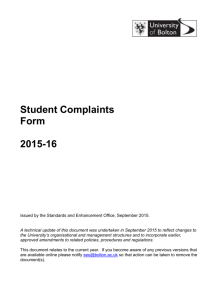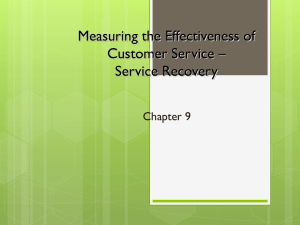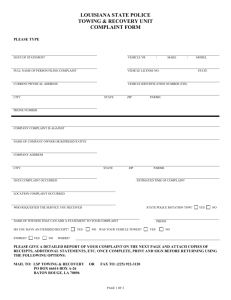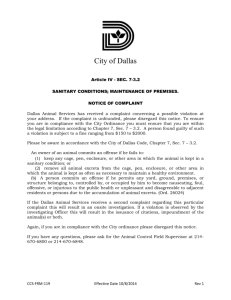"Making Sense of Customers` Responses to Service Recovery:
advertisement
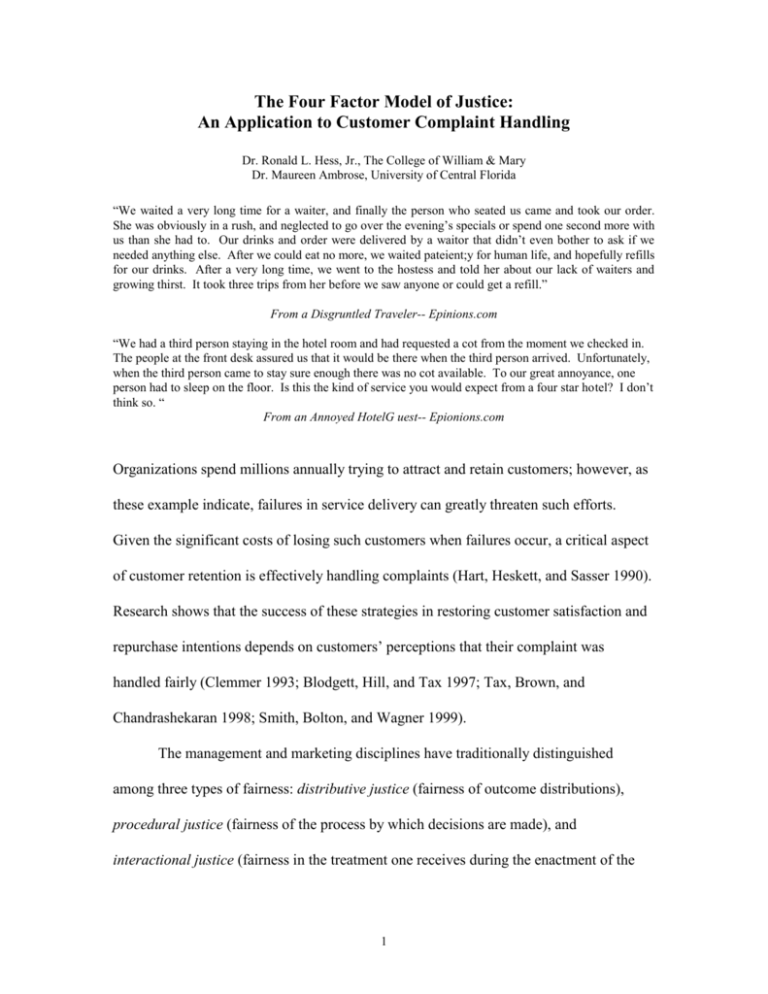
The Four Factor Model of Justice: An Application to Customer Complaint Handling Dr. Ronald L. Hess, Jr., The College of William & Mary Dr. Maureen Ambrose, University of Central Florida “We waited a very long time for a waiter, and finally the person who seated us came and took our order. She was obviously in a rush, and neglected to go over the evening’s specials or spend one second more with us than she had to. Our drinks and order were delivered by a waitor that didn’t even bother to ask if we needed anything else. After we could eat no more, we waited pateient;y for human life, and hopefully refills for our drinks. After a very long time, we went to the hostess and told her about our lack of waiters and growing thirst. It took three trips from her before we saw anyone or could get a refill.” From a Disgruntled Traveler-- Epinions.com “We had a third person staying in the hotel room and had requested a cot from the moment we checked in. The people at the front desk assured us that it would be there when the third person arrived. Unfortunately, when the third person came to stay sure enough there was no cot available. To our great annoyance, one person had to sleep on the floor. Is this the kind of service you would expect from a four star hotel? I don’t think so. “ From an Annoyed HotelG uest-- Epionions.com Organizations spend millions annually trying to attract and retain customers; however, as these example indicate, failures in service delivery can greatly threaten such efforts. Given the significant costs of losing such customers when failures occur, a critical aspect of customer retention is effectively handling complaints (Hart, Heskett, and Sasser 1990). Research shows that the success of these strategies in restoring customer satisfaction and repurchase intentions depends on customers’ perceptions that their complaint was handled fairly (Clemmer 1993; Blodgett, Hill, and Tax 1997; Tax, Brown, and Chandrashekaran 1998; Smith, Bolton, and Wagner 1999). The management and marketing disciplines have traditionally distinguished among three types of fairness: distributive justice (fairness of outcome distributions), procedural justice (fairness of the process by which decisions are made), and interactional justice (fairness in the treatment one receives during the enactment of the 1 procedures) (Clemmer 1993; Blodgett, Hill, and Tax 1997; Tax, Brown, and Chandrashekaran 1998; Smith, Bolton, and Wagner 1999; Smith and Bolton 2002). Recently, Greenberg (1993) argued that this traditional three factor model of justice is better conceptualized as four different types of justice. He suggested that in addition to distributive and procedural justice, interactional justice be split into two distinct types of justice: interpersonal justice, defined as the fairness of interpersonal treatment provided during the enactment of procedures and distributions of outcomes, and informational justice, defined as the fairness of explanations and information. Recently, empirical research in management has appeared that supports the four factor model of justice (Colquitt 2001; Colquitt, Conlon, Wesson, Porter and Ng 2001) and that interpersonal and informational justice have unique effects on managerial outcomes (Colquit 2001). For example, Colquitt (2001) found that interpersonal justice was related to helping behavior, whereas informational justice was related to collective esteem. An application of the four factor model to a marketing context (specifically to customer complaint handling) is lacking but definitely needed. One of the purposes of this paper, therefore, is to explore the theoretical dimensionality of justice by explicitly comparing the traditional three factor model and the four-factor model in the context of customer complaint handling. A second purpose of this article is to understand how these types of justice differentially impact important customer outcomes following organizational complaint handling (Clemmer 1993; Blodgett, Hill, and Tax 1997). Understanding which type of justice impacts certain customer outcomes is essential if effective complaint handling strategies are to be implemented. For example, if distributive justice has an impact on 2 satisfaction with complaint handling, whereas informational justice has an effect on repatronage intentions, these findings have important implications for how organizations should design organizational complaint handling procedures, train their employees, and treat customers following service failures. Within this study we will examine the dimensionality of justice by comparing several different models of justice (one factor, two factor, three factor, and four factor model of justice). We will also determine which type of justice is related to different customer outcomes, such as repurchase intentions, trust with the organization, and negative word-of-mouth behavior. We begin by defining organizational complaint handling and justice. Then, we offer a set of hypotheses that address our proposed research questions. Literature Review and Hypotheses Despite their best efforts, organizations sometime fail to deliver products or services that customers expect. When failures occurs, organizational complaint handling becomes a critical part of customer retention and, if well executed, offers organizations an opportunity to restore customer confidence, satisfaction, repatronage intentions, and loyalty (Clemmer 1993; Blodgett, Hill, and Tax 1997; Tax, Brown, and Chandrashekaran 1998; Smith, Bolton, and Wagner 1999; Smith and Bolton 2002). Research on complaint handling demonstrates that the perceived fairness of how the complaint is handled affects several customer outcomes. Next, we review the types of justice that are central to customers’ perceptions of complait handling. Distributive Justice 3 Distributive justice is the perceived fairness of outcome allocations, and is typically evaluated with respect to the equity of those outcome distributions (Adams 1965; Deutsch 1985; Homans 1961). Researchers in marketing have shown that complaint handling activities that involve tangible compensation in the form of reimbursement, product/service replacement, credit, apology, repair, refund, correction, and additional tangible compensation positively affect customer perceptions of distributive justice (Goodwin and Ross 1992; Tax, Brown, and Chandrashekaran 1998; Smith, Bolton, and Wagner 1999). Moreover, this research demonstrates that the perceived distributive justice of complaint handling positively affects customers’ reactions, including satisfaction with the encounter (Smith, Bolton, and Wagner 1999; Smith and Bolton 2002), outcome satisfaction (Clemmer 1993), satisfaction with complaint handling (Goodwin and Ross 1992; Tax, Brown, and Chandrashekaran 1998; Maxham and Netemeyer 2002), repatronage intentions (Blodgett, Hill, and Tax 1997), overall satisfaction/return intentions (Clemmer 1993; Maxham and Netemeyer 2002), and perceptions of fairness (Goodwin and Ross 1992), and decreases negative word-of-mouth (Blodgett, Hill, and Tax 1997). Procedural Justice Procedural justice refers to the perceived fairness of the process(es) by which allocation decisions are made. Early work on procedural justice identified several procedural rules that influence perceptions of fairness: consistency, accuracy, representativeness (voice), bias suppression, correctability, and ethicality (Leventhal 1980; Leventhal, Karuza, and Fry 1980; Thibaut and Walker 1975). Research demonstrated that when individuals believed procedures were fair, they were more 4 satisfied with the outcome they received, even when the outcome was unfavorable (Thibaut and Walker 1975; Lind and Tyler 1988). Researchers in marketing have shown that customer perceptions of procedural justice are based on convenience, flexibility, timeliness (of response), opportunity to voice, process control, process knowledge, helpfulness, efficiency, assumption of responsibility, and follow-up (Tax, Brown, and Chandrashekaran 1998; Clemmer 1993; Conlon and Murray 1996; Goodwin and Ross 1992). Customers’ perceptions that complaint handling processes are fair have a positive effect on many outcomes such as, satisfaction with the encounter (Smith, Bolton, and Wagner 1999; Smith and Bolton 2002), outcome satisfaction (Clemmer 1993), satisfaction with complaint handling (Tax, Brown, and Chandrashekaran 1998), overall satisfaction (Maxham and Netemeyer 2002), repurchase intentions (Clemmer 1993; Maxham and Netemeyer 2002) and a negative effect on negative word-of-mouth behaviors (Maxham and Netemeyer 2002). Interpersonal Justice and Informational Justice In the traditional model of justice, individuals are also sensitive to interactional justice, the fairness of the treatment that one receives during the enactment of procedures (Bies and Moag 1986; Tax, Brown, and Chandrashekaran 1998; Blodgett, Hill, and Tax 1997; Smith, Bolton, and Wagner 1999). Researchers generally agree that there are two dimensions of interactional justice: interpersonal sensitivity and explanations (Bies and Shapiro 1988; Greenberg 1993). Research demonstrates that both interpersonal sensitivity and explanations affect individuals’ perceptions of fairness (Brockner and Greenberg 1990; Greenberg 1993b, 1994;). Interactional fairness perceptions, in turn, 5 have been shown to affect individuals’ attitudes and behaviors (Cropanzano and Greenberg 1997). Researchers in marketing have shown that empathy, effort, politeness, friendliness, sensitivity, apology, explanation, justification, lack of bias, and honesty are important factors influencing customers’ perceptions of interactional justice (Goodwin and Ross 1992; Clemmer 1993; Conlon and Murray 1996; Tax, Brown, and Chandrashekaran 1998; Smith, Bolton, and Wagner 1999). Research indicated that interactional justice positively affects satisfaction with the encounter (Smith, Bolton, and Wagner 1999; Smith and Bolton 2002), outcome satisfaction (Clemmer 1993), satisfaction with complaint handling (Tax, Brown, and Chandrashekaran 1998; Maxham and Netemeyer 2002), repatronage intentions (Blodgett, Hill, and Tax 1997; Maxham and Netemeyer 2002), overall satisfaction/return intentions (Clemmer 1993; Maxham and Netemeyer 2002), and decreases negative word-of-mouth (Blodgett, Hill, and Tax 1997). Most research on justice treats interactional justice as a third type of justice while distinguishing between its two sub-dimensions: interpersonal sensitivity and explanations (Bies 2001; Cropanzano, Byrne, Bobocel, and Rupp 2001; Cohen-Charash and Spector 2001). However, as described previously, Greenberg (1993) suggested these two dimensions of interactional justice are better conceptualized as two distinct forms of justice: interpersonal justice, defined as the fairness of interpersonal treatment provided during the enactment of procedures and distributions of outcomes, and informational justice as the fairness of explanations and information. In management, Colquitt (2001) has shown that the four factor model management provides superior fit to alternative models of justice such as the one factor, two factor model, and three factor models of 6 justice. Thus, we propose that the dimensionality of justice will be best exemplified with four factors compared to the traditional three factor conceptualization. H1: The fit of the four factor model of justice will be superior to the alternative models of justice (i.e., three, two, or one factor models). Differential Effects of Justice on Customer Outcomes Previous research in marketing has established relationships among distributive, procedural, interactional (containing interpersonal justice and informational justice) and satisfaction with complaint handling (Goodwin and Ross 1992; Tax, Brown, and Chandrashekaran 1998; Maxham and Netemeyer 2002). We also expect that distributive and procedural justice will impact satisfaction with complaint handling. However, recall that the four factor model divides interactional justice into two distinct parts-interpersonal justice and informational justice-- and we propose that these types of justice will be related to very different customer outcomes. First, we expect that interpersonal justice will affect satisfaction with complaint handling. This proposed relationship is consistent with Greenberg (1993) who states that interpersonal justice, because it reflects issues such as sensitivity, politeness, dignified behavior, and respect, can ease an individual’s response to decision outcomes (i.e., complaint handling outcomes), especially if these outcomes are unfavorable. In contrast, we propose that informational justice will have a unique affect on global or organizational centered outcomes such as repurchase intentions, trust in the organization, and negative word-of-mouth. Greenberg (1993) states that informational justice should affect long-term or organizational-centered outcomes because explanations and open communications provide individuals with information necessary to assess the 7 systemic bases of existing procedures. Indeed, Colquitt et al. (2001, p. 427)) claims that “informational justice acts primarily to alter reactions to procedures, in that explanations provide the information needed to evaluate structural (i.e., organizational defined) aspects of the process.” This perspective is also reflected by Tyler and Bies (1989) who suggests that candid communication with group members may decrease perceptions of secrecy and dishonesty of the group, enhancing perceptions that the overall group is trustworthy. Thus, in the context of complaint handling, we expect that informational justice will be related to global or organizational centered outcomes (e.g., repurchase intentions, trust with the organization, and negative word-of-mouth). H2: Distributive justice, procedural justice, and interpersonal justice will be related to satisfaction with complaint handling. H3: Informational justice will be related to repurchase intentions, trust with the organization, and negative word-of-mouth behaviors . Research Methodology Design and Sample We used a cross-sectional survey design to collect perceptions about product and service complaint experiences. This protocol is similar to those used in much previous research focusing on evaluations of failures, complaining behavior, and complaint handling (Tax, Brown, and Chandrashekaran 1998; Clemmer 1993). The sampling frame used for this study was passengers waiting for flights at departure gates at a major international airport. Permission was formally requested from several major airlines for such a survey, and one granted permission. Respondents were approached by researchers who introduced themselves, described the purpose of the study, and asked for their 8 participation by completing the survey. A cover letter reiterated the purpose of the study, identified the two principal researchers and university affiliations, and guaranteed anonymity of all responses. Three-hundred thirteen surveys were collected with 285 being usable. The sample was composed of 40% men, 60% women, with a mean age of 38 years. In terms of level of education completed, the sample included: 15.1% high school, 24% some college, 29.3% undergraduate degree, 10.7% some graduate education, and 20.9% graduate degrees. Overall, we believe that our sample is a well-represented convenience sample. Procedure Respondents were asked to think about a service problem that they experienced and complained about to someone in the organization within the previous six months. The survey began with a series of open-ended questions requesting respondents to describe in detail the problem that occurred, with whom within the organization they discussed the incident, and what actions were taken to resolve the problem. These openended questions were used to elicit detailed information from memory and assist with the retrieval of feelings and evaluations about the incident. Following these open-ended questions, respondents were asked fixed response and evaluative questions concerning their incident. Next, we asked for their evaluations about how the company responded to their problem(s). These questions addressed their perceptions of distributive, procedural, interpersonal, and informational justice. Then, we included items assessing their satisfaction with complaint handling, repurchase intentions, trust with the organization, and negative word-of-mouth behaviors. Finally, demographic information and measures of control variables were requested. The respondents were then thanked and debriefed. 9 10 Measures of Constructs and Control Variables The measures used in this study, source of the measures, and the coefficient alphas for each measure are presented in Appendix A. Measures of distributive, procedural, interpersonal, and informational justice were based on those developed recently by Colquitt (2001). These measures, originally developed for use in a management context, were adapted for use in a marketing context1. Only minor modifications of the wording were necessary. The measurement of satisfaction with complaint handling, trust, repurchase intentions, and negative word-of-mouth were based on established measures from Oliver and Swan (1989) and Tax, Brown, and Chandrashekaran (1998). We also collected information about perceptions of the severity of the failure, disconfirmation, importance of the product or service, and various demographic information, such as gender, age, and level of education. These control variables were chosen because previous research reported that these were influential in complaint handling situations (Smith, Bolton, and Wagner 1999; Hess, Ganesan, and Klein 2003). Analysis and Results Confirmatory Factor Analysis In order to test the first hypothesis, we performed a confirmatory factor analysis with intercorrelated factors using LISREL 8.30 (Joreskog and Sorbom 1998). Four different conceptual models of jstice were tested-- one factor, two factor, three factor, and four factor models. These four factor structures were compared because each model has appeared recently in the marketing and management literatures and considerable debate exists in the management discipline about which model provides the best fit. Such a test 11 has never been conducted in the marketing discipline. For the one factor model, we assigned all items shown in the Appendix to a single factor. Next, the two factor model was tested with distributive justice as one factor and procedural justice encompassing the items for procedural, interpersonal, and informational justice. The three factor model contained items designated for distributive justice, procedural justice, and interactional justice, with interactional justice subsuming the items for interpersonal and informational justice. Finally, the four factor model included separate factors for distributive, procedural, interpersonal, and informational justice. A comparison of fit statistics for these models is shown in Table 1. Overall, it shows that the four factor model provides a superior fit compared to the other three models. First, we assessed the chi-square statistic which provides a measure of absolute fit of the implied covariances to the observed covariances. A chi-square closer to 0 signifies a better fit. The table indicates that the four factor model is superior to the three alternative models. Many researchers are critical of the chi-square statistic because it is sensitive to differences in sample size. Hence, we also compared the four models using a ratio of chi-square and degrees of freedom. According to Arbuckle (1997), ratios closer to 2 are indicative of superior fit. Given this criterion, our results reveal that the four factor model, with a ratio of 2.55, is superior to the one, two, and three factor models. We also examined the incremental fit index (IFI) and the comparative fit index (CFI). These indices compare the fit of the proposed model to a baseline model. Indices approaching 1.0 exemplify models with superior fit, with 0.90 representing the established threshold for good fit (Bentler 1990). Consistent with previous results, the four factor model provides superior fit (CFI = 0.95, IFI = 0.95) compared with the three 12 alternative models. The final criteria used was the root-mean-square error of approximation (RMSEA) which designates how well the model compares to the population covariance matrix (Brown and Cudeck 1993). These authors define good fit as an RMSEA between 0.05 and 0.08. The four factor model exemplifies superior fit (RMSEA = 0.07) compared to the three alternative models. Overall, the fit indices summarized in Table 1 clearly demonstrates the superior fit of the four factor model compared to the three alternative models and supports Hypothesis 1. Analysis of the Structural Model Given that the four factor model provided superior fit, we used this model to test H2 which proposed that distributive, procedural, and interpersonal justice were related to satisfaction with complaint handling, and H3 which proposed that informational justice was related to global or organizational cenetered outcomes such as, repurchase intentions, trust with the organization, and negative word-of-mouth. To test H2 and H3, we included these hypothesized paths in a structural model using LISREL 8.30 (Joreskog and Sorbom 1998). The fit indices of our structural model are presented in Table 2 and show that the proposed structural model provides good fit to the data, as each index approaches or exceeds established criteria: IFI = 0.94, CFI = 0.94, RMSEA = 0.061, and the SRMR = 0.048 (Browne and Cudeck 1993; Bentler and Bonett 1980). The percentage of variance explained for each of our dependent variables is also quite high at 80% for satisfaction with complaint handling, 47% for repurchase intentions, 63% for trust, and 64% for negative word-of-mouth. The structural model provides full support for H2, which hypothesized that distributive justice (β = 0.50, p < 0.01), procedural justice (β = 0.29, p < 0.01), and 13 interpersonal justice (β = 0.23, p < 0.01) would be related to satisfaction with complaint handling. It is also worth noting that informational justice is not significantly related to satisfaction with complaint handling. Our results also provide support for H3 which stated that informational justice would be related to repurchase intentions (β = 0.26, p < 0.01), trust with the organization (β = 0.27, p < 0.01), and negative word-of-mouth (β = 0.24, p < 0.01). A check of modification indices did not suggest adding paths from distributive, procedural, or interpersonal justice to these outcomes. Thus, as proposed, our results indicate that informational justice is the only type of justice that has a significant impact on these important customer consequences. In the following section, we discuss the theoretical and practical implications of our findings. Discussion Our study examined the theoretical dimensionality of justice by comparing the fit of four models of justice within the context of complaint handling. We also investigated whether distributive, procedural, interpersonal, and informational justice were uniquesly related to satisfaction with complaint handling, repurchase intentions, trust with the organization, and negative word-of-mouth. Our findings showed that the four factor model which proposed that justice is best conceptualized as containing four factors, distributive, procedural, interpersonal, and informational justice, provides the best fit to the data compared with three popular alternative models of justice. This research is the first to use and compare the four factor model within a complaint handling context. We also examined the differential impact of the four types of justice on important customer outcomes. Overall, we found support for the fact that customers’ judgments of distributive, procedural, and interpersonal justice influence their evaluations of how the 14 complaint had been handled (i.e., satisfaction with complaint handling). Our results also show that informational justice has no significant relationship with satsifaction with complaint handling. Instead, informational justice influences global or organizational centered outcomes such as repurchase intentions, trust with the organization, and negative word-of-mouth. Taken together, these findings clearly demonstrate the unique impact that informational justice has on how organizations handle customer complaints. ENDNOTES Within our survey, we also included justice measures that have been utilized in previous marketing research (see Tax, Brown, and Chandrashekaran 1998; Smith, Bolton, and Wagner 1999). However, the Colquitt (2001) measures provided better overall convergent and discriminant validity. Thus, we used these measures in our analyses. 15 TABLE 1 Comparison of Four Models of Justice Models Chi-Sq. (df) 1-Factor Model 2-Factor Model 3-Factor Model 4-Factor Model 1804.8 (152) 1119.08 (151) 702.64 (149) 372.75 (146) Chi-Sq./df Ratio 11.87 7.41 4.72 2.55 IFI CFI RMSEA 0.63 0.78 0.88 0.95 0.63 0.78 0.88 0.95 0.24 0.18 0.13 0.07 TABLE 2 Fit Indices for the Measurement and Structural Models Models Chi-Sq. (df) IFI CFI RMSEA SRMR Measurement Model Structural Model 808.72 (377) 829.89 (387) 0.94 0.94 0.94 0.94 0.063 0.061 0.046 0.048 16 References Adams, Stacy J. (1965), “Inequity in Social Exchanges,” in Advances in Experimental Social Psychology, Vol. 2, Leonard Berkowitz ed. New York: Academic Press, 267-99. Arbuckle, J. L. (1997), Amos Users’ Guide (Version 3.6), Chicago: Small-Waters Corporation. Bentler, P. M. and Douglas Bonett (1980), Significance Tests and Goodness of Fit in the Analysis of Covariance Structures,” Psychological Bulletin, 88 (3), 588-606. Bentler, P. M. (1990), “Comparative Fit Indices in Structural Models, Psychological Bulletin, 107, 238246. Bies, Robert J and Moag, Joseph S, (1986), “Interactional Justice: Communication Criteria for Fairness,” in Research on Negotiation in Organizations (Vol. 1), B. Sheppard ed. Greenwich, CT: JAI Press, 43-55. Bies, R. J. and D. L. Shapiro (1988), “Voice and Justification: Their Influence on Procedural Fairness Judgments,” Academy of Management Journal, 31, 676-685. Blodgett, Jeffrey G., Donna J. Hill, and Stephen S. Tax (1997), “The Effects of Distributive, Procedural, and Interactional Justice on Post-Complaint Behavior,” Journal of Retailing, 73 (2), 185-210. Browne, Michael W. and Robert Cudeck (1993), “Alternative Ways of Assessing Model Fit,” in Testing Structural Equation Models, Kenneth A. Bollen and J. Scott Long, eds. Newbury Park, California: Sage Publications, Inc., 136-62. Clemmer, Elizabeth C. (1993), “An Investigation into the Relationships of Justice and Customer Satisfaction with Services,” in Justice in the Workplace: Approaching Fairness in Human Resource Management, R. Cropanzano, ed. Hillsdale, NJ: Erlbaum, 193-207. Colquitt, Jason A. (2001), “On the Dimensionality of Organizational Justice: A Construct Validation of a Measure,” Journal of Applied Psychology, 86, 386-400. Colquitt, Jason A., Conlon, Donald E., Wesson, Michael. J., Porter, Christopher O. L. H., & Ng, K. Yee (2001), Justice at the Millennium: A Meta-Analytic Review of 25 Years of Organizational Justice Research, Journal of Applied Psychology, 86, 425-445. Conlon, D. E., and N. M. Murray (1996), “Customer Perceptions of Corporate Responses to Product Complaints: The Role of Explanations,” Academy of Management Journal, 39, 1040-1056. Cropanzano, Russell., Byrne, Zinta S., Bobocel, D. R., & Rupp, Deborah R. (2001), “Moral Virtues, Fairness Heuristics, Social Entities, and Other Denizens of Organizational Justice. Journal of Vocational Behavior, 58, 164-209. ----, and Jerald Greenberg (1997), Progress in Organizational Justice: Tunneling Through the Maze,” in International review of industrial and organizational psychology, L. T. Robertson and C. L. Cooper eds. New York: John Wiley & Sons, 317-72. Deutsch, Morten (1985), Distributive Justice: A Social-Psychological Perspective. New Haven, CT: Yale University Press. Goodwin, Cathy and I. Ross (1990), “Consumer Responses to Service Failures: Influence of Procedural and Interactional Fairness Perceptions,” Journal of Business Research, 25, 149-163. 17 Greenberg, Jerald (1993), “The Social Side of Fairness: Interpersonal and Informational Classes of Organizational Justice,” in Justice in the Workplace: Approaching Fairness in Human Resource Management, Russell Cropanzano, ed., Hillsdale, NJ: Lawrence Erlbaum Associates, 79-103. Greenberg, Jerald (1994), “Using Socially Fair Treatment to Promote Acceptance of a Work Site Smoking Ban,” Journal of Applied Psychology, 79, 288-297. Hart, Christopher W. L., James L. Heskett, and W. Earl Sasser, Jr. (1990), “The Profitable Art of Service Recovery,” Harvard Business Review, July-August, 148-156. Hess, Ronald L. Jr., Shankar Ganesan and Noreen M. Klein (2003), “Service Failure and Recovery: The Impact of Relationship Factors on Customer Satisfaction,” Journal of the Academy of Marketing Science, 31 (Spring), 127-145. Homans, George Casper (1961), Social Behavior: Its Elementary Forms, New York: Harcourt, Brace & World. Joreskog, Karl and Dag Sorbom (1998), LISREL 8.2: Structural Equation Modeling with the Simplis Command Language, Chicago, IL: Scientific Software International, Inc. Leventhal, G. S., J. Karuza, and W. R. Fry (1980), “Beyond Fairness: A Theory of Allocation Preferences. In G. Mikula (ed.), Jutice and Social Interaction (pp. 167-218), New York: Springer-Verlag. Lind, E. Allen and Tyler, Tom R. (1988), The Social Psychology of Procedural Justice. New York: Plenum. Maxham, James G., and Richard Netemeyer (2002), “Modeling Customer Perceptions of Complaint Handling Over Time: The Effects of Perceived Justice on Satisfaction and Intent,” Journal of Retailing, 78, 239-252. Smith, Amy K., Ruth N. Bolton, and Janet Wagner (1999), “A Model of Customer Satisfaction with Service Encounters Involving Failure and Recovery,” Journal of Marketing Research, 36 (August), 356-72. ---- and ---- (2002), “The Effects of Customers’ Emotional Responses to Service Failures on their Recovery Effort Evaluations and Satisfaction Judgments,” Journal of the Academy of Marketing Science, 30 (1), 5-23. Tax, Stephen S., Stephen W. Brown, and Murali Chandrashekaran. (1998), “Customer Evaluations of Service Complaint Experiences: Implications for Relationship Marketing,” Journal of Marketing, 62 (April), 60-76. 18 Measures of Contructs Interpersonal Justice (Adapted from Colquitt in press) (Alpha = .91) During the process of resolving your complaint, to what extent: (5-point scale) 1. 2. 3. 4. Did they treat you in a polite manner? Did they treat you with dignity? Did they treat you with respect? Did they refrain from improper remarks or comments? Informational Justice (Adapted from Colquitt 2001) (Alpha = .87 ) During the process of resolving your complaint, to what extent: (5-point scale) 1. 2. 3. 4. 5. Were they candid in communications with you? Did they explain thoroughly the procedures used to make decisions about your complaint? Were their explanations regarding the procedures used to make decisions about your complaint reasonable? Did they communicate details in a timely manner? Did they seem to tailor (his/her/their) communications to your specific needs? Procedural Justice (Adapted from Colquitt 2001) (Alpha = .88) During the process of resolving your complaint, to what extent: (5-point scale) 1. 2. 3. 4. 5. 6. 7. Were you able to express your views and feelings during those procedures? Did you have influence over the outcomes arrived at by those procedures? Were those procedures applied consistently? Were those procedures free of bias? Were those procedures based on accurate information? Were you able to appeal the outcomes arrived at by those procedures? Did those procedures uphold ethical and moral standards? Distributive Justice (Adapted from Colquitt 2001) (Alpha = .97) To what extent: (5-point scale) 1. 2. 3. 4. Did your outcomes reflect what you deserved? Were your outcomes appropriate given the experience you had? Did your outcomes reflect a fair resolution? Were your outcomes justified, given your problem? Satisfaction with Complaint Handling (Adapted from Oliver and Swan 1989) (Alpha = .85) Satisfaction with the Organization (Alpha = .85) (7-point scale) (Strongly Agree --- Strongly Disagree) 1. 2. 3. I am unhappy with how the organization handled my complaint. ( R ) I am satisfied with how the organization handled my complaint. I am pleased with the manner in which the complaint was dealt with. 1. 2. 3. I am unhappy with the organization. ( R ) I am satisfied with the organization. I am pleased with the organization. 19 "The Four Factor Model of Justice: An Application to Customer Complaint Handling " Dr. Ronald L. Hess, Jr. Assistant Professor of Marketing School of Business Administration The College of William & Mary P.O. Box 8795 Williamsburg, VA 23187-8795 (757) 221-2676 (757) 221-2937 (fax) ron.hess@business.wm.edu Dr. Maureen Ambrose Professor of Management University of Central Florida Management Department P.O. Box 161400 Orlando, FL 32816-1400 (407) 823-5684 (407) 823-3725 (fax) maureen.ambrose@bus.ucf.edu 20

